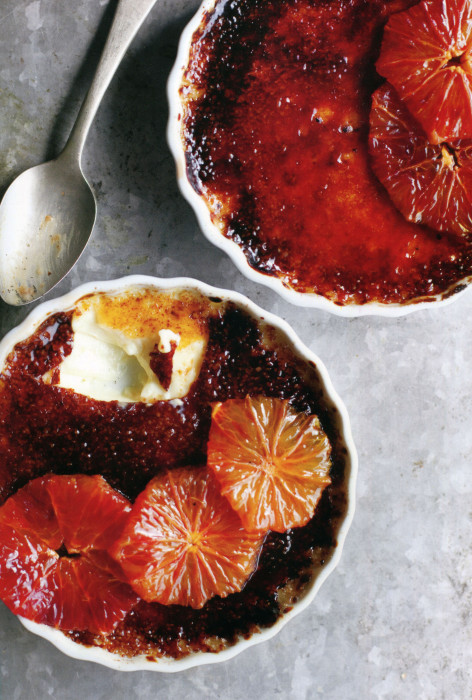I’m not sure what it is about crème brûlée that makes it so positively addictive. It is addictive, you know. But, that addiction could never be considered bad. Fattening, but not bad.
It may be the creamy texture that coats your mouth. It may be the coolness. Though of course, warm out of the oven is equally good. The crunchy sugar crust? The toppings: fruit or chocolate. Or just everything about it from first bite to last. I have never asked for seconds for dessert, but I always think about it.
One thing is very certain: this is a dessert that will impress everyone, including you. There’s a little effort involved and it takes a little time. But if you have an afternoon to bide away before your dinner party, if you devote some love and energy, then the magnificence here is certain to be appreciated and applauded.
This recipe and the photo come from Home Baked Comfort by Kim Laidlaw with photography by Eric Wolfinger. The book is published by WeldonOwen and is part of their excellent Williams-Sonoma Series. This is a book, and a series, you should investigate. This recipe is representative of the creations that are ready for your home kitchen. It’s elevated comfort food.
Crème Brûlée with Caramelized Blood Oranges
Yield: serves 8
Ingredients:
For the crème brûlées:
- 3 cups heavy cream
- ½ cup granulated sugar
- ⅛ teaspoon kosher salt
- 1 vanilla bean
- 8 large egg yolks
For the caramelized blood oranges:
- 2 blood oranges
- ¼ granulated sugar
- 6-8 teaspoons turbinado sugar
Preparation:
Position a rack in the middle of the oven and preheat to 300°F. Have ready 6-8 shallow custard cups or ramekins, each ½ to 1 cup, and a baking pan large enough to hold all the cups.
In a saucepan, stir together the cream, granulated sugar, and salt. Split the vanilla bean and scrape out the seeds with the back of a paring knife. Add the seeds and pod to the cream. Bring to a very gentle boil over medium heat, stirring constantly. Turn off the heat, cover, and let stand for 20 minutes.
Meanwhile, in a bowl, whisk the egg yolks just to break them up. Whisking constantly, slowly add the cream mixture to the yolks. Pour through a fine-mesh sieve into a pitcher. Divide the mixture among the custard cups. Place the cups in the baking pan and carefully pour hot water into the pan to reach about halfway up the sides of the cups (I usually add the water once I place the pan on the oven rack). Bake until the custards are just set but still jiggly, 30-35 minutes.
Carefully remove the custards from the water bath, and let cool on a wire rack to room temperature. Cover with plastic wrap pressed directly onto the surface of the custards to prevent a skin from forming. Refrigerate until the custards are thoroughly chilled, at least 2 hours or up to 2 days.
To make the caramelized oranges, trim the ends from each orange, then remove the peel with a paring knife, following the contour of the fruit and making sure to remove all the white pith. Cut each orange crosswise into thin slices, removing any seeds as you go. In a saucepan, stir together the granulated sugar and 2 tablespoons water. Cook over medium-high heat, swirling the pan occasionally, until the syrup turns a deep amber caramel. Immediately remove from the heat, add the orange slices, and swirl the pan to coat them evenly.
Just before serving, preheat the broiler. Sprinkle each custard with about 1 teaspoon of the turbinado sugar, covering the surface with a thin, even layer. Place the custards on a baking sheet and slide into the broiler about 3 inches from the heat source. The sugar will melt quickly and caramelize; watch carefully so that the custards do not burn. (You can also melt and caramelize the sugar with a kitchen torch.) Set the custards aside to harden for a few minutes, then top with some of the caramelized oranges.
Source [recipe and photo]: Home Baked Comfort by Kim Laidlaw [WeldonOwen, 2014]

